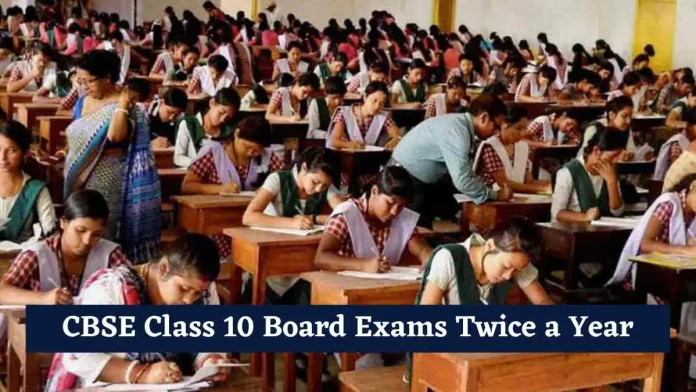The Central Board of Secondary Education (CBSE) has announced a transformative reform in India’s education system, approving norms to conduct Class 10 board examinations twice a year starting from the 2026 academic session.
This significant shift, aligned with the National Education Policy (NEP) 2020, aims to reduce exam-related stress, provide flexibility, and foster a student-centric approach to learning.
The decision has been widely discussed and welcomed by students, educators, and stakeholders, marking a monumental change in how board exams are perceived and conducted in India.
This article delves into the details of this reform, its implications, benefits, challenges, and the broader vision of CBSE to make education more holistic and globally competitive.
Background and Context
The CBSE, one of India’s largest and most prominent educational boards, oversees the academic framework for millions of students across the country and in 260 affiliated international schools.
Traditionally, Class 10 board exams have been a high-stakes, single-attempt evaluation held annually in February-March, determining students’ academic progression.
The pressure associated with these exams has long been a concern, often leading to stress, anxiety, and an over-reliance on rote learning.
The NEP 2020, introduced by the Government of India, emphasizes a flexible, holistic, and student-friendly education system.
One of its key recommendations is to eliminate the “high-stakes” nature of board exams by allowing students multiple opportunities to demonstrate their capabilities.
The CBSE’s decision to conduct Class 10 board exams twice a year is a direct response to this vision, aiming to create a stress-free learning environment while maintaining academic rigor.
Key Features of the Biannual Exam System
The CBSE has outlined a clear structure for the biannual Class 10 board exams, with the following key features:
- Two Exam Phases: The first phase of the board exams will be conducted in mid-February, and the second phase will take place in May. Results for the first phase will be announced in April, and for the second phase in June.
- Mandatory First Phase: All Class 10 students are required to appear for the February exam. This ensures that every student participates in the primary evaluation cycle, maintaining consistency in the academic calendar.
- Optional Second Phase: The May exam is optional and designed for students who wish to improve their performance. Students can choose to reappear in up to three subjects, including science, mathematics, social science, and languages. The higher score from the two attempts will be retained for the final mark sheet.
- Single Internal Assessment: Despite the dual-exam format, internal assessments (such as projects, practicals, and periodic tests) will be conducted only once during the academic year. This streamlines the evaluation process for both students and educators.
- Flexibility for Winter-Bound Regions: Students in winter-bound areas, where harsh weather may disrupt the February exam schedule, will have the option to appear in either phase, ensuring inclusivity.
- No Semester System: The CBSE has clarified that it will not adopt a semester system, as speculated earlier. Instead, the biannual exams will cover the entire syllabus, ensuring comprehensive evaluation.
These features reflect CBSE’s commitment to balancing flexibility with academic standards, creating a system that supports diverse student needs while maintaining fairness and transparency.
Alignment with National Education Policy 2020
The biannual exam system is a cornerstone of NEP 2020’s vision to transform India’s education landscape. The policy advocates for:
- Reduced Exam Stress: By offering two attempts, the CBSE aims to alleviate the pressure of a single high-stakes exam, allowing students to perform at their best without fear of failure.
- Competency-Based Learning: The reform emphasizes assessing students’ understanding, critical thinking, and problem-solving skills over rote memorization. CBSE plans to incorporate more competency-based questions in the exams to align with this goal.
- Student-Centric Education: The optional second phase empowers students to take control of their academic journey, fostering confidence and resilience.
- Holistic Development: By reducing exam-related anxiety, the CBSE seeks to create space for students to engage in extracurricular activities, skill development, and personal growth.
The NEP 2020 also encourages alignment with global education systems, such as the SAT in the US, where students can take multiple attempts and submit their best scores.
The CBSE’s reform draws inspiration from such models, positioning Indian education on a global stage.
Benefits of the Biannual Exam System
The decision to conduct Class 10 board exams twice a year offers several advantages for students, educators, and the education system as a whole:
- Stress-Free Learning Environment: The opportunity to improve scores in the second phase reduces the fear of failure, creating a more relaxed and supportive academic atmosphere. Students who face challenges like illness, exam anxiety, or personal issues during the first attempt can redeem themselves in May.
- Improved Academic Performance: The option to reappear in up to three subjects allows students to focus on specific areas for improvement, potentially leading to higher overall scores. This flexibility is particularly beneficial for students aiming to excel in competitive exams or pursue higher education abroad.
- Inclusivity and Equity: The policy accommodates students from diverse backgrounds, including those in remote or winter-bound regions. It ensures that no student is disadvantaged due to external factors, promoting fairness.
- Encouragement of Continuous Learning: The biannual system encourages students to engage with the curriculum throughout the year, rather than cramming for a single exam. This fosters a deeper understanding of concepts and long-term retention.
- Global Competitiveness: By adopting a multi-attempt exam model, CBSE aligns Indian education system with international standards, preparing students for global academic and professional challenges. The introduction of the CBSE Global Curriculum in foreign-affiliated schools further enhances this competitiveness.
- Reduced Dependence on Coaching: The focus on competency-based assessments and multiple exam opportunities may reduce reliance on coaching centers, which often prioritize rote learning over conceptual understanding.
Challenges and Concerns
While the biannual exam system has been largely welcomed, it also presents certain challenges that need to be addressed:
- Increased Workload for Teachers: Conducting two exam phases annually may increase the administrative and evaluative burden on teachers. Some educators have expressed concerns about reduced summer breaks and the need for additional resources to manage the process.
- Logistical Complexities: Organizing two board exams, including scheduling, question paper preparation, and result processing, requires meticulous planning and infrastructure. The CBSE must ensure that exam centers, invigilators, and evaluation systems are adequately equipped.
- Student Preparedness: While the second phase is optional, students may feel pressured to reappear to improve their scores, potentially leading to additional stress. Proper counseling and guidance will be essential to help students make informed decisions.
- Maintaining Academic Standards: Critics worry that multiple attempts could dilute the rigor of board exams. The CBSE must ensure that question papers remain challenging and aligned with the curriculum to uphold quality.
- Public Awareness and Feedback: The CBSE released draft norms in February 2025, inviting stakeholder feedback until March 9. Incorporating diverse perspectives and addressing concerns will be crucial to refining the policy.
The CBSE has acknowledged these challenges and is working to streamline processes, enhance teacher training, and ensure robust infrastructure to support the reform.
CBSE Global Curriculum: A Parallel Initiative
In addition to the biannual exam system, CBSE plans to introduce a Global Curriculum for its 260 affiliated international schools starting from the 2026-27 academic session.
This curriculum will integrate core Indian subjects with international standards, ensuring that students abroad receive an education rooted in Indian values while remaining globally relevant. Key features include:
- Cultural Integration: The curriculum will emphasize Indian heritage, history, and values, fostering a sense of identity among Indian students abroad.
- Global Relevance: By incorporating international standards, the curriculum prepares students for global academic and professional opportunities.
- Competency-Based Learning: Similar to the domestic reforms, the global curriculum will prioritize critical thinking, problem-solving, and practical application of knowledge.
This initiative underscores CBSE’s vision to make Indian education a global benchmark, catering to the needs of Indian diaspora while promoting cross-cultural understanding.
Stakeholder Reactions
The announcement has elicited varied responses from stakeholders:
- Students: Many students have welcomed the reform, appreciating the opportunity to improve their scores without waiting an entire year. The reduced pressure of a single exam is seen as a significant relief.
- Parents and Principals: School principals and parents have largely supported the move, citing its potential to create a more balanced and inclusive evaluation system. However, some parents seek clarity on how the optional phase will impact college admissions.
- Teachers: While teachers acknowledge the benefits for students, some are concerned about the increased workload and logistical demands. Enhanced training and support will be critical to address these concerns.
- Education Experts: Experts view the reform as a progressive step toward modernizing Indian education, aligning it with global best practices. They emphasize the need for robust implementation to realize its full potential.
The CBSE’s proactive approach to seeking public feedback demonstrates its commitment to inclusivity and transparency in policy-making.
Implementation Roadmap
The CBSE has outlined a clear timeline for implementing the biannual exam system:
- February 2025: Draft norms released for public consultation, with feedback accepted until March 9.
- June 2025: Finalization of the policy based on stakeholder inputs, followed by official guidelines.
- 2025-26: Teacher training programs, infrastructure upgrades, and awareness campaigns to prepare schools and students for the new system.
- 2026: Rollout of the biannual Class 10 board exams, with the first phase in February and the second in May.
The board is also collaborating with the Ministry of Education, NCERT, KVS, and NVS to ensure a smooth transition. High-level meetings, chaired by Education Minister Dharmendra Pradhan, have been instrumental in shaping the policy.
The CBSE’s decision to conduct Class 10 board exams twice a year from 2026 is a landmark reform that promises to reshape India’s education system.
By prioritizing flexibility, inclusivity, and competency-based learning, the policy aligns with the NEP 2020’s vision of a student-centric, stress-free, and globally competitive education framework.
While challenges remain, the CBSE’s proactive approach to stakeholder engagement and implementation planning inspires confidence in its success.
This reform not only benefits students by reducing exam pressure and enhancing learning outcomes but also positions Indian education as a model for innovation and excellence.
As the CBSE prepares to roll out this system alongside its Global Curriculum, it is poised to create a brighter, more equitable future for millions of students in India and beyond.

